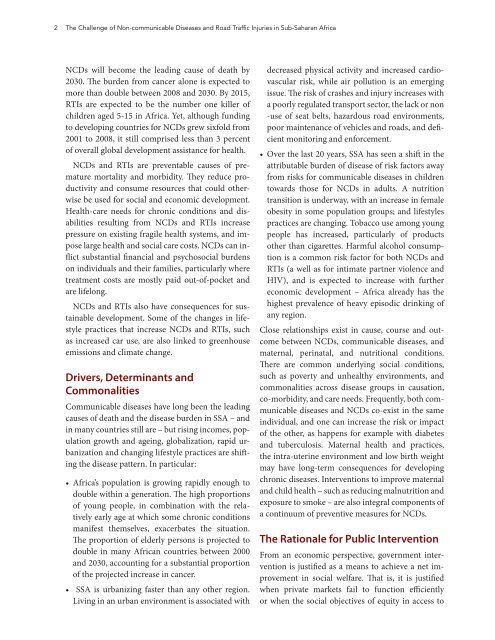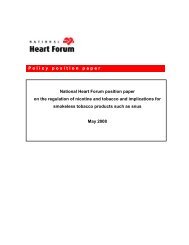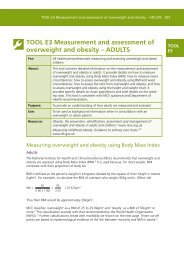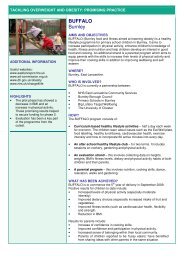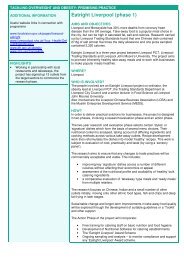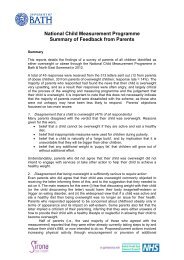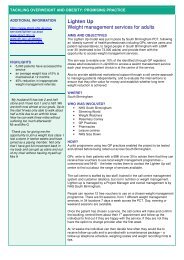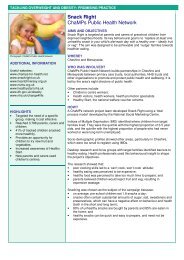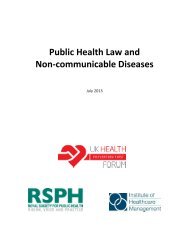The Challenge of Non-Communicable Diseases and Road Traffic ...
The Challenge of Non-Communicable Diseases and Road Traffic ...
The Challenge of Non-Communicable Diseases and Road Traffic ...
Create successful ePaper yourself
Turn your PDF publications into a flip-book with our unique Google optimized e-Paper software.
2 <strong>The</strong> <strong>Challenge</strong> <strong>of</strong> <strong>Non</strong>-communicable <strong>Diseases</strong> <strong>and</strong> <strong>Road</strong> <strong>Traffic</strong> Injuries in Sub-Saharan Africa<br />
NCDs will become the leading cause <strong>of</strong> death by<br />
2030. <strong>The</strong> burden from cancer alone is expected to<br />
more than double between 2008 <strong>and</strong> 2030. By 2015,<br />
RTIs are expected to be the number one killer <strong>of</strong><br />
children aged 5-15 in Africa. Yet, although funding<br />
to developing countries for NCDs grew sixfold from<br />
2001 to 2008, it still comprised less than 3 percent<br />
<strong>of</strong> overall global development assistance for health.<br />
NCDs <strong>and</strong> RTIs are preventable causes <strong>of</strong> premature<br />
mortality <strong>and</strong> morbidity. <strong>The</strong>y reduce productivity<br />
<strong>and</strong> consume resources that could otherwise<br />
be used for social <strong>and</strong> economic development.<br />
Health-care needs for chronic conditions <strong>and</strong> disabilities<br />
resulting from NCDs <strong>and</strong> RTIs increase<br />
pressure on existing fragile health systems, <strong>and</strong> impose<br />
large health <strong>and</strong> social care costs. NCDs can inflict<br />
substantial financial <strong>and</strong> psychosocial burdens<br />
on individuals <strong>and</strong> their families, particularly where<br />
treatment costs are mostly paid out-<strong>of</strong>-pocket <strong>and</strong><br />
are lifelong.<br />
NCDs <strong>and</strong> RTIs also have consequences for sustainable<br />
development. Some <strong>of</strong> the changes in lifestyle<br />
practices that increase NCDs <strong>and</strong> RTIs, such<br />
as increased car use, are also linked to greenhouse<br />
emissions <strong>and</strong> climate change.<br />
Drivers, Determinants <strong>and</strong><br />
Commonalities<br />
<strong>Communicable</strong> diseases have long been the leading<br />
causes <strong>of</strong> death <strong>and</strong> the disease burden in SSA – <strong>and</strong><br />
in many countries still are – but rising incomes, population<br />
growth <strong>and</strong> ageing, globalization, rapid urbanization<br />
<strong>and</strong> changing lifestyle practices are shifting<br />
the disease pattern. In particular:<br />
• Africa’s population is growing rapidly enough to<br />
double within a generation. <strong>The</strong> high proportions<br />
<strong>of</strong> young people, in combination with the relatively<br />
early age at which some chronic conditions<br />
manifest themselves, exacerbates the situation.<br />
<strong>The</strong> proportion <strong>of</strong> elderly persons is projected to<br />
double in many African countries between 2000<br />
<strong>and</strong> 2030, accounting for a substantial proportion<br />
<strong>of</strong> the projected increase in cancer.<br />
• SSA is urbanizing faster than any other region.<br />
Living in an urban environment is associated with<br />
decreased physical activity <strong>and</strong> increased cardiovascular<br />
risk, while air pollution is an emerging<br />
issue. <strong>The</strong> risk <strong>of</strong> crashes <strong>and</strong> injury increases with<br />
a poorly regulated transport sector, the lack or non<br />
-use <strong>of</strong> seat belts, hazardous road environments,<br />
poor maintenance <strong>of</strong> vehicles <strong>and</strong> roads, <strong>and</strong> deficient<br />
monitoring <strong>and</strong> enforcement.<br />
• Over the last 20 years, SSA has seen a shift in the<br />
attributable burden <strong>of</strong> disease <strong>of</strong> risk factors away<br />
from risks for communicable diseases in children<br />
towards those for NCDs in adults. A nutrition<br />
transition is underway, with an increase in female<br />
obesity in some population groups; <strong>and</strong> lifestyles<br />
practices are changing. Tobacco use among young<br />
people has increased, particularly <strong>of</strong> products<br />
other than cigarettes. Harmful alcohol consumption<br />
is a common risk factor for both NCDs <strong>and</strong><br />
RTIs (a well as for intimate partner violence <strong>and</strong><br />
HIV), <strong>and</strong> is expected to increase with further<br />
economic development – Africa already has the<br />
highest prevalence <strong>of</strong> heavy episodic drinking <strong>of</strong><br />
any region.<br />
Close relationships exist in cause, course <strong>and</strong> outcome<br />
between NCDs, communicable diseases, <strong>and</strong><br />
maternal, perinatal, <strong>and</strong> nutritional conditions.<br />
<strong>The</strong>re are common underlying social conditions,<br />
such as poverty <strong>and</strong> unhealthy environments, <strong>and</strong><br />
commonalities across disease groups in causation,<br />
co-morbidity, <strong>and</strong> care needs. Frequently, both communicable<br />
diseases <strong>and</strong> NCDs co-exist in the same<br />
individual, <strong>and</strong> one can increase the risk or impact<br />
<strong>of</strong> the other, as happens for example with diabetes<br />
<strong>and</strong> tuberculosis. Maternal health <strong>and</strong> practices,<br />
the intra-uterine environment <strong>and</strong> low birth weight<br />
may have long-term consequences for developing<br />
chronic diseases. Interventions to improve maternal<br />
<strong>and</strong> child health – such as reducing malnutrition <strong>and</strong><br />
exposure to smoke – are also integral components <strong>of</strong><br />
a continuum <strong>of</strong> preventive measures for NCDs.<br />
<strong>The</strong> Rationale for Public Intervention<br />
From an economic perspective, government intervention<br />
is justified as a means to achieve a net improvement<br />
in social welfare. That is, it is justified<br />
when private markets fail to function efficiently<br />
or when the social objectives <strong>of</strong> equity in access to


